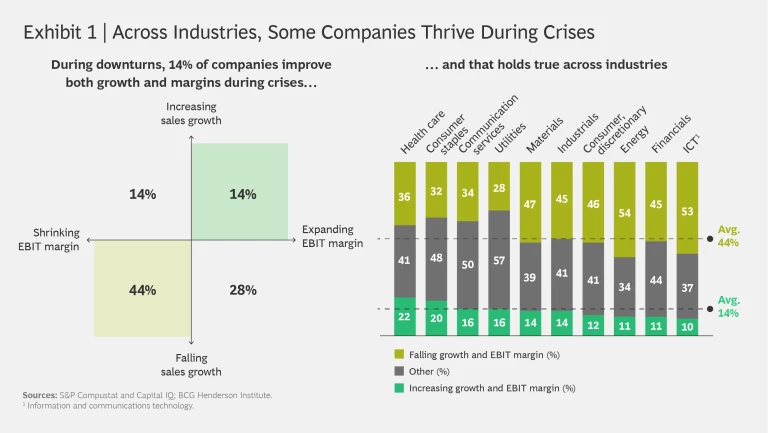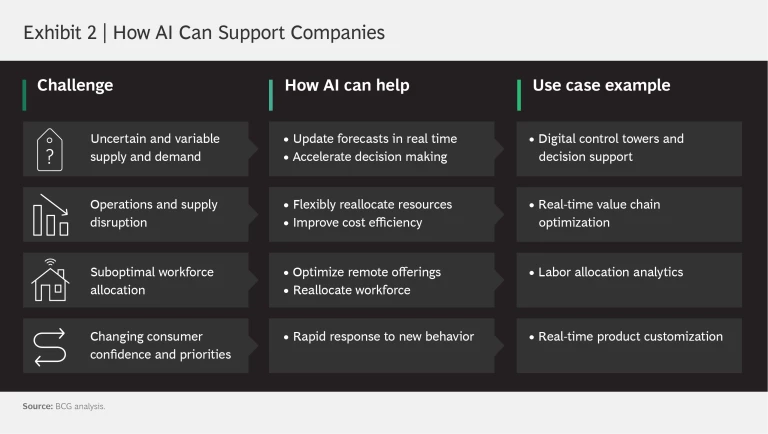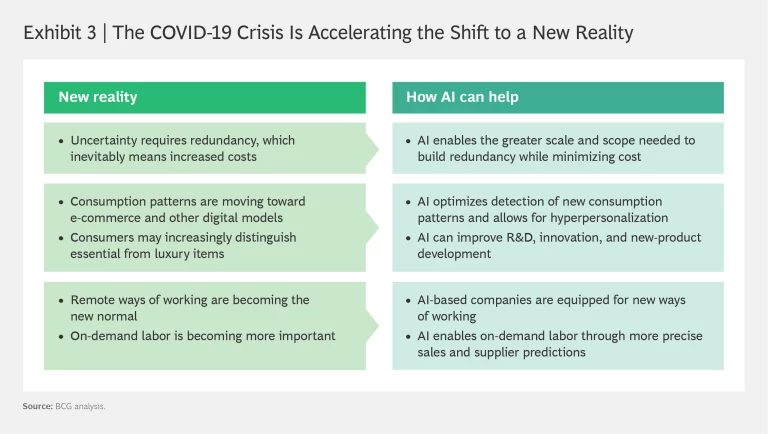For some companies, global shocks have historically brought moments of truth. They can rapidly alter the business landscape and the terms of competition, often in ways that aren’t immediately apparent. But companies that make bold moves during challenging times can turn adversity into advantage . The SARS outbreak of 2003 is often credited with giving rise to e-commerce giants such as Alibaba and JD.com, for example, while companies such as American Express and Starbucks pivoted during the global financial crisis of 2008−2009 to digital operating models that enabled them to thrive and dramatically increase shareholder value.
In this sense, COVID-19 is likely to be no different from other crises. It will greatly accelerate several major trends that were already well underway before the outbreak and that will continue as companies shift their focus to recovery. For instance, rather than heavily concentrating sourcing and production in a few low-cost locations, companies will build more redundancy into their value chains. Consumers will purchase more and more goods and services online. And increasing numbers of people will work remotely.
We believe that the application of artificial intelligence will be immensely valuable in helping companies adapt to these trends. Advanced robots that can recognize objects and handle tasks that previously required humans will promote the operation of factories and other facilities 24/7, in more locations and with little added cost. AI-enabled platforms will help companies better simulate live work environments and create on-demand labor forces. Through machine learning and advanced data analytics, AI will help companies detect new consumption patterns and deliver “hyperpersonalized” products to online customers. The most successful use cases will be those that seamlessly combine AI with human judgment and experience.
Some companies that are on the forefront of these trends and have already begun the AI journey will thrive in the post-COVID world. Again, history provides a guide: during the four previous global economic downturns, 14% of companies were actually able to increase both sales growth and profit margins, according to Boston Consulting Group research. (See Exhibit 1.) The majority of companies, however, are at the very early stages of the journey—or have yet to begin.
Success will not be easy. Some companies have already launched AI use cases that will be helpful in the current crisis. The challenge will be to scale them up. Those that do will be better able to navigate uncertain supply and demand, adjust to disruptions in operations and supply chains, allocate their workforces, and adapt to sharp changes in consumer confidence and priorities.
Digital natives may have an initial edge. Other companies will have to act quickly to acquire the skills, capabilities, and ways of working needed to begin the AI journey. But regardless of their starting point, companies must look beyond the COVID-19 crisis and begin focusing on transformations that put AI at their core.
Why AI Will Be a Must in the Post-COVID World
Most companies already have extensive experience with digital applications such as automation and basic data analytics. But AI, which enables machines to solve problems and take actions that in the past could only be done by humans, goes far beyond that. AI tools analyze immense volumes of data to learn underlying patterns, enabling computer systems to make complex decisions, predict human behavior, and recognize images and human speech, among many other things. AI-enabled systems also continuously learn and adapt.
These capabilities will be enormously valuable as companies confront and adapt to the new reality of the current crisis and its aftermath. (See Exhibit 2.)
This new reality will significantly impact companies’ costs, revenue, and operating models. Below we assess how the global business landscape is changing along three dimensions—value chain redundancy, shifting consumption patterns, and remote ways of working—and the role that AI can play in enabling companies to thrive and seize competitive advantage in this new environment. (See Exhibit 3.)
Value Chain Redundancy
Not long ago, optimizing cost and time was the overarching objective in the design of global manufacturing footprints, supply chains, and logistical support. Often, that meant concentrating production in high-volume factories in one or two low-cost nations. Inventory and excess capacity were equated with waste. But recently, rising economic nationalism and trade barriers (two aspects of the “new globalization” ) began forcing companies to rethink their supply chain strategies and rediscover the merits of redundancy. The COVID-19 crisis, which has disrupted global supply chains, has moved redundancy higher up on companies’ agendas as a means of reducing risk and weathering the next global shock.
But redundancy and duplication entail significant cost. AI offers the potential for companies to build resilience into manufacturing operations and supply chains, while at the same time minimizing cost and damage to margins. AI enables manufacturers to optimize cost in each factory through predictive maintenance and better planning. It also allows them to operate a larger number of small, efficient facilities nearer to customers—rather than a few massive factories in low-wage nations—by deploying advanced manufacturing technologies such as 3D printing and autonomous robots that require few workers.
A leading shoe manufacturer, for example, illustrates AI’s potential to boost scale at minimal additional cost. The company now assembles some of its shoes 20 times faster using advanced robots that can recognize, pick up, and stack a wide variety of materials—tasks that were previously done by humans. What’s more, factories of the future will increasingly be able to operate around the clock, reducing the risk of closure forced by health crises.
Changing Consumption Patterns
The pandemic is already drastically altering consumption habits worldwide—and affecting companies’ revenues—as people make more purchases online and consume food and beverages exclusively at home. Amazon is dramatically ramping up its fulfillment capacity, while online grocery marketplaces in China are reporting huge increases in deliveries of fresh vegetables. Movies are being released for digital streaming without even being released in theaters, and fitness companies such as Peloton and Hydrow are launching digital home-fitness services. What’s more, long periods of forced isolation, combined with anxiety about an economic recession, could cause consumers to cut back on luxury items in favor of essentials.
As their focus shifts to recovery, more companies are likely to deploy AI-enabled solutions to reignite topline growth. Thanks to its ability to analyze data from myriad sources, AI has unparalleled potential to discover emerging trends and identify changes in consumer preferences. Even in a human-centered industry like fashion, some companies are augmenting their business intelligence capabilities with AI to amplify weak signals and detect trends early on, such as which colors are likely to be popular in the coming season. AI also enables companies to hyperpersonalize products in order to improve customer engagement and sales. Starbucks’ Deep Brew platform, for example, makes coffee suggestions based on the weather, the time of day, or a customer’s previous purchases and taste profile.
As their focus shifts to recovery, more companies are likely to deploy AI-enabled solutions to reignite topline growth.
AI can also enhance the ideation process involved in creating new product offerings, and it can significantly accelerate R&D in industries such as pharmaceuticals, which has traditionally relied on a lengthy trial-and-error process to develop new drugs. Makers of fast-moving consumer goods are analyzing the gold mine of consumer data on Alibaba’s TMIC consumer analytics platform to develop new products tailored to Chinese consumers (such as a chili-flavored Snickers candy bar) and to monitor the performance of new products. Finally, AI-enabled generative design can autonomously identify an optimal product design from a set of system requirements in the development of everything from buildings and chairs to aircraft components.
Remote Ways of Working
Some of the massive shift to remote work due to the pandemic may be temporary. But much of it will persist as more people experience the benefits of avoiding hourlong commutes and more managers find they can work effectively from home. The flexible working arrangements and on-demand labor models associated with the so-called The New Freelancers: Tapping Talent in the Gig Economy will become more common.
Companies will need to leverage innovative ways of engaging human resources to mitigate the risk of further disruptions and remain competitive. AI is no silver bullet for implementing new ways of working, but it can play an important role. To begin with, AI-powered companies have natural advantages in remote work situations because they tend to be built around modularity and agility, which are prerequisites to success in software-centric businesses. AI also supports online marketplaces for high-skilled, on-demand labor. Upwork, for instance, is an AI-enabled platform that connects freelance professionals with potential employers, while Google’s Kaggle allows an online community of data scientists and machine-learning practitioners to collaborate and solve data challenges. Finally, AI tools enable companies to use predictive analytics to more precisely forecast sales and operational challenges, such as labor needs and supply disruptions.
Putting AI at the Core of Business and Operating Models
The current crisis and its aftermath should motivate companies to adjust their business models to the new reality. Winners will reinvent themselves by putting software, data, and AI at the core of their organizations. Digitally native companies can serve as inspiration. AI is already at the heart of some leading ride-hailing platforms, for example, identifying the best routes, onboarding drivers, and even helping to detect fraud. Some long-established incumbents in sectors as diverse as mass retail and consumer finance are now transforming themselves in preparation for an AI-based future.
Such a transformation requires that AI be regarded as central to the business model that differentiates a company and defines how it creates value, as well as to its operating model—the systems, processes, and capabilities that deliver value. Data must underlie every aspect of the operating model, providing critical input to a broad range of tasks while also allowing for a smaller-scale organization. In Competing in the Age of AI, Marco Iansiti and Karim Lakhani call on companies to build an “AI factory,” which they describe as a “scalable decision engine that powers the digital operating model of the 21st century firm.”
In the crisis and its aftermath, winning companies will reinvent themselves by putting software, data, and AI at the core of their organizations.
Companies must apply AI at scale to unlock the value of data, and they must operate in an agile manner at scale to enable nimble, data-driven teams. Companies also need the right supporting IT infrastructure. They should migrate away from legacy enterprise resource planning (ERP) platforms, with modules that typically are poorly interfaced, toward data management centers of excellence that pool and provide data throughout the organization. Success in this transition will require a strong focus on change management. According to joint BCG and MIT research, to a good rule of thumb is to dedicate around 10% of AI investment to algorithms, 20% to technology, and 70% to business process transformation.
Five Principles for Building a Human-Powered AI Company
We believe a successful AI-centered operating model needs to integrate human judgment and experience at its core. Here are five guiding principles to building what we call a “human plus AI” operating model.
1. Bring leadership onboard by building the case for change. Strong leadership commitment is key to successful transformations . One powerful way for the leader of an AI initiative to convince the CEO or board to support bold moves is to demonstrate how little the company is gaining from AI compared with its competitors. A simple acid test: ask the CEO or board members if they can identify at least two critical, strategic processes where the consensus is that AI can make a real difference—an impact of $100 million, say. Then ask if they think the company has made progress on those fronts. Failure to answer yes to both questions means the company isn’t doing AI right and dramatic change is needed.
2. Reimagine the organization with AI at its core. Once a company’s leadership has come to support bold change, it should consider another disruptive question: How would a new AI-based firm provide the same, or enhanced, value to its customers? Answering that question requires a shift away from the traditional tradeoff between scale and marginal costs. Everything should be based on human plus AI—so long as AI adds value. As Alibaba’s chief strategy officer, Ming Zeng, has said, “Your firm must enable as many operating decisions as possible to be made by machines fueled by live data.”
3. Transform into a human-powered AI company. Even with AI placed at the core, it is crucial to avoid a “zero-human mindset.” Indeed, the human role must be elevated to ensure that there is no area in which AI operates unchecked. Even the most autonomous algorithms and applications need humans to provide the contextual understanding and expertise that AI typically lacks, and to guard against bad judgment or biases. At one point during the COVID-19 crisis, for example, website traffic on a popular British online grocery marketplace soared fourfold. The company’s AI-based cybersecurity software interpreted this spike as evidence of a denial-of-service attack and acted to block new transactions. Fortunately, company staff were standing by to correct that mistake.
Even with AI placed at the core, it is crucial to avoid a “zero-human mindset.”
AI must be augmented by the imagination and interpretation of human beings. Companies should refocus its people on tasks that add the most value, such as designing algorithms, reshaping processes to implement human plus AI integration, strategically monitoring AI inputs and outputs, and engaging in holistic decision making that takes into account second-order implications. A good example of how human plus AI can work together is forecasting in the fashion industry. AI can reduce forecasting errors by 25%, but not all fashion trends can be detected by mining historical data. In our work with one company, we found that combining AI with human expertise could reduce forecasting errors by 50%.
4. Contain or discard legacy processes. When reinventing the company for AI, it is important to redesign legacy processes, technology, and organizational structures from the top down. Trying to augment preexisting workflows and legacy ERP platforms by “plugging in” AI is a mistake. Realizing the potential of AI requires consistent, companywide application. And while the top-down redesign of organizational structures allows for the elimination of unnecessary layers, that doesn’t mean everything has to go. Certain applications and infrastructure that have strong interfaces and are able to connect with the central data infrastructure can be retained. But these features should be assessed after the redesign, and the desire to retain them cannot be allowed to influence the transformation.
5. Prepare people now for the change. AI systems require a fundamentally different mindset and new capabilities. Preparing employees for change is critical. An absence of leadership and organizational support can cause users to detach, cede responsibility, and avoid risk. Companies must provide employees with on-the-job learning opportunities to master new skills. At a bare minimum, they must understand what AI can and cannot do so they’re able to work with the new technology.
A BCG survey of responses to the COVID-19 crisis found that most companies have focused so far on reactive measures. But now is the perfect time to take bold, transformative action. Companies that have already introduced AI use cases should press ahead immediately in order to achieve maximum impact in the near term. They should not hesitate to scale up, because AI will be a significant lever that can help them manage this crisis. Unless they are digital natives that already have AI at their core, companies should view the current slowdown in day-to-day operations as an opportunity for strategic reflection about how value creation mechanisms are changing—and how to prepare for the postcrisis world. They should start preparing and reskilling their people and increasing their loyalty, enthusiasm, and long-term value in the coming age of AI.
The BCG Henderson Institute is the Boston Consulting Group’s strategy think tank, dedicated to exploring and developing valuable new insights from business, technology, and science by embracing the powerful technology of ideas. The Institute engages leaders in provocative discussion and experimentation to expand the boundaries of business theory and practice and to translate innovative ideas from within and beyond business. For more ideas and inspiration follow us on
LinkedIn
and Twitter: @BCGHenderson.















